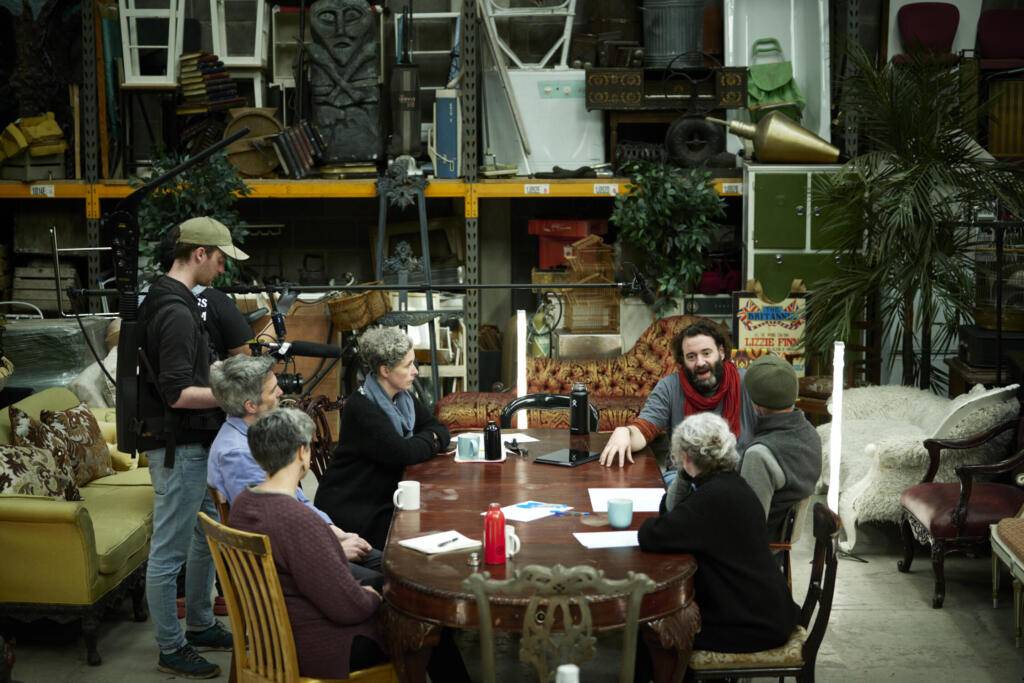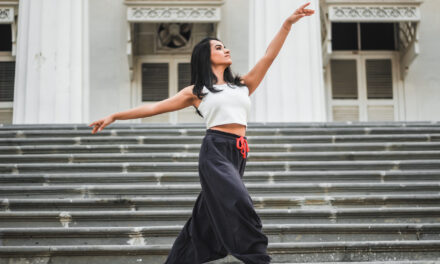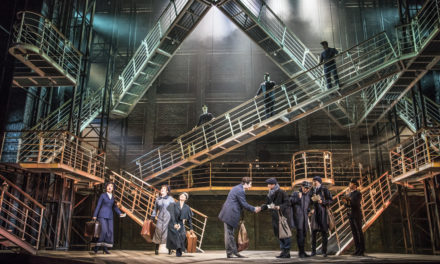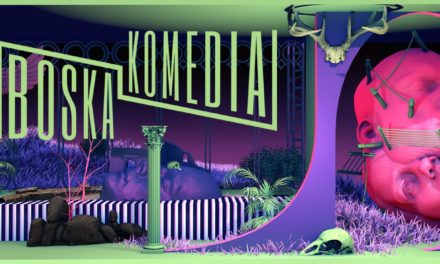Being on the edge is the place where I like to be no matter in what domain it is…and the edge is a place which overlaps with other edges…so you’re likely to meet other people round the edge…But part of the problem is that you’re often not too seen by the centre.
Mel Mercier, multi-disciplinary, award-winning, Tony-nominated artist
Mercier offers these reflections during the documentary The Next Four Years, ‘a speculative retrospective of Irish performance design and scenography in the years 2023-2027, challenging the designers of today to imagine the theatre of tomorrow’ (Tom Creed, Curator’s Note, ISPD.ie/Once-Off Productions). Following the contribution of eight Irish designers across costume, lighting, set, props, music, sound, and video for the 2023 Prague Quadrennial, a two-week event every four years that brings together designers from around the world since 1967, they come together to explore, visualise, and prepare for the road ahead. And that road is a classically Irish one, riddled with potholes, bumps, twists, and yet, beautiful scenery enticing you to stay on the journey despite the discomfort.
Designers’ focus is usually directed at crafting the worlds we see and hear – their borders, temporalities and sensations. Part of their job involves ensuring we experience the design but not the designer nor the work of production. In this moment, they invite us into their own world, where the deepening cracks of a sector on the edge are rendered visible: labour shortages, inflation, reduced budgets and by consequence, reduced time and space to be creative and interact creatively with others. The result is not only shifts in practice but generational absences. Which precise straw broke the camel’s back may differ amongst the creative workforce: it could be a doubling of overheads such as rental costs, material costs, or travel costs for touring. It could be a ‘restructured’ budget that demands a reduced rehearsal schedule when the pre-existing norm was already considered insufficient. It could be choosing to produce the one-person show rather than a performance with an ensemble cast, as the wage bill cannot be met. Or it could be that they worked so hard to keep the show on the road (literally) during the last recession, they cannot rationalise doing it again. These issues and more are further examined in the Life Worth Living (2020) report, prepared by the Arts and Culture Recovery Taskforce.
What can be done for artists, companies, and the stability of the sector? The recent trial of Basic income for the Arts provides a meaningful step forward that has injected some hope that the value of both art and artist is being considered. Arts and cultural policy often look to Nordic and European countries as examples of best practice for arts funding, value, and experience. For example, the ‘Culture Pass’ concept is a government sponsored incentive encouraging young people to experience culture in a variety of forms. It has been adopted in Italy, France, Spain and Germany with vouchers ranging from €380-€500. Germany is the most recent convert to the Culture Pass, following emergency aid of €1 billion for the arts sector during Covid in 2020, followed by another €1 billion top-up in 2021. Returning to models of multi-annual funding for a minimum of 3 years that caters to both arts organisations and individual artists may also offer some stability. However, it is difficult for an Arts Council to make such commitments when they themselves receive annual funding – subject to variations – and thus, may not be in a position to offer greater economic security.

The Next Four Years. Image by Ros Kavanagh.
While significant arts funding is essential, it does not provide a complete solution to the current sectoral challenges. Which metrics of value are adopted to rank ‘success’ may benefit from further debate. Querying embedded ideas of ‘excellence’ could be a starting point here. There is nothing wrong with the ambition for excellence per say, yet it can be perceived as a largely subjective concept and usually evidenced by commercial metrics. Art that unsettles the soul, or makes entire generations want to dance, has nothing to do with chasing pennies. It has everything to do with human connection. Human connection is about linking the group, not lifting the individual. Arts sectors globally are made vulnerable by a neoliberal prioritising of ‘excellence’ rather than fostering of sustenance. With sustained nourishment for the collective, ‘excellence’ and ‘success’ take care of themselves.
The history of storytelling is rich on the island of Ireland, which more often than not has linked the group – fueled in part by a complex history of colonial violence, poverty and emigration. To tell one’s story was to claim one’s identity, an act as political as it was personal. There is an inheritance of how to tell a story stretching back to the tradition of the ‘seanchaí’ (storyteller), and also, a social understanding that the act of storytelling is a community gesture – formative, collaborative, and nourishing. This recent and deserved success of Irish creative voices on the international stage is a joyous occasion, such as Cillian Murphy’s Golden Globe for Best Male Actor in Oppenheimer, and Paul Lynch’s Booker Prize win for Prophet Song. Yet we must be cautious to acknowledge that the context for producing and sustaining a viable arts sector domestically is in need of more acute attention. There will be no great scripts to produce and parts to play if the designers, technical experts, production managers and wider crew are not in place. Storytelling is a collaborative act, and thus, working conditions should be appropriate for all.
If the world of work could be redesigned for the designers, and indeed, entire arts communities, what might that look like? What borders, temporalities and sensations might emerge? If we cannot improve domestic conditions, then by default, are we training artists for emigration? Conversation and connection are central to forging this path ahead, as we cannot rely on past trends and traditions. Identifying challenges should not be conflated with complaining, which only leads to processes of self-silencing and removing opportunities for brave ideas. Perhaps artist and arts manager Lian Bell best captures this sectoral crossroads in the documentary, stating, ‘If you’re asking me how to become whatever it is I am, you have to work it out for yourself, I’m afraid….I’m thinking about the shape of a river. The river has changed shape since I went down it’ (The Next Four Years). Let’s look at the river, its shape, the directions it may flow, and ensure it doesn’t run dry.
The Next Four Years is freely available to view here: https://ispd.ie/
Authors
Dr Miriam Haughton is Associate Professor in Drama and Theatre Studies at the University of Galway, President of the Irish Society for Theatre Research, and PI of ‘The Price of Performance’ research project sponsored by the Irish Research Council.
Dr Patricia O’Beirne is postdoctoral researcher on ‘The Price of Performance’ research project at the University of Galway sponsored by the Irish Research Council.
This post was written by the author in their personal capacity.The opinions expressed in this article are the author’s own and do not reflect the view of The Theatre Times, their staff or collaborators.
This post was written by Miriam Haughton and Patricia O’Beirne.
The views expressed here belong to the author and do not necessarily reflect our views and opinions.


















